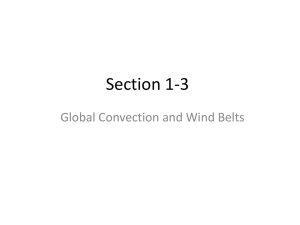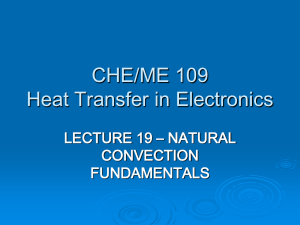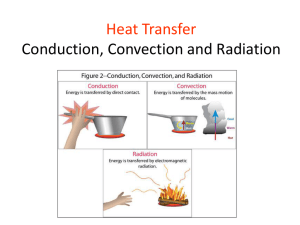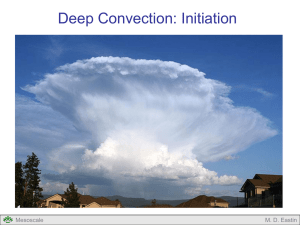Boundary layer of shallow and deep convection
advertisement
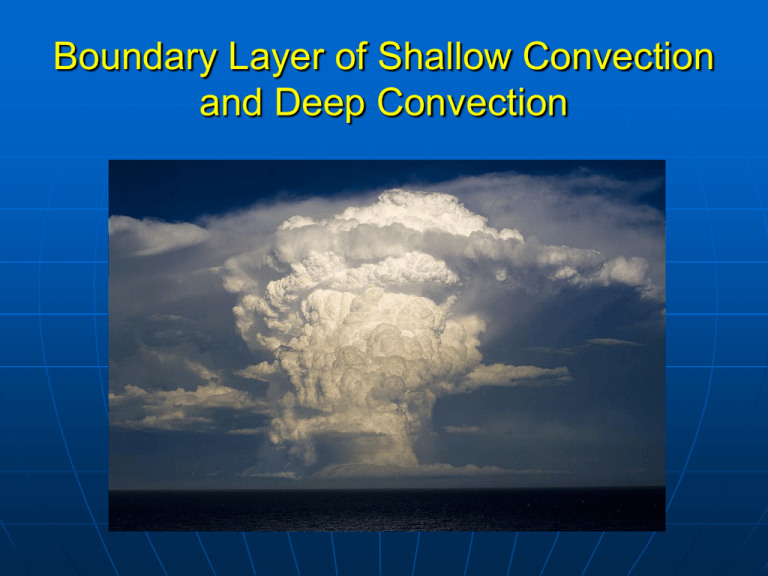
Boundary Layer of Shallow Convection and Deep Convection Review of last lecture Definition of stratocumulus clouds Global distribution Importance for global warming Vertical structure and formation mechanism of STBL Modeling of STBL: non-local forced by surface heating and cloud-top cooling Global distribution of shallow convection and deep convection Deep convection Shallow convection From Shumacher and Houze (2003) Hadley circulation and cloud types Tropics L Deep convection H Trade wind cumulus Stratocumulus Walker circulation and cloud types Deep convection Trade wind cumulus Stratocumulus Trade wind cumulus Cloud top height generally below 4 km Often associated with light rain Sometimes topped by stratocumulus Deep convection Cloud top height above 9 km Generally associated with rain Sometimes organized into mesoscale convective systems Vertical structure of deep convection: Four components High θe Convective updrafts (controlled by lower troposphere moisture) Mesoscale updrafts Low θe Mesoscale downdrafts High θe Convective downdrafts Zipser (1977), modified by Houze (1993) Differences in boundary layer structure Stratocumulus has shallow well-defined BL Trade wind cumulus has deep well-defined BL Deep convection does not have well-defined BL Trade wind cumulus Deep convection Stratocumulus Differences in boundary layer T and q Trade wind cumulus Deep convection Differences between shallow convection and deep convection: Change of boundary layer T Shallow/midtop convection: T decreases Deep convection: T decreases Differences between shallow convection and deep convection: Change of boundary layer q Shallow/midtop convection: q increases Deep convection: q decreases Differences between shallow convection and deep convection: Change of boundary layer moist static energy h Moist static energy h = Cp T + L q + g z Shallow/midtop convection: h keeps constant Deep convection: h decreases Convective wake of deep convection Self-suppression processes in deep convection Missing physics III, IV High θe Convective updrafts (controlled by lower troposphere temperature and moisture) Mesoscale updrafts Low θe Missing physics II Mesoscale downdrafts High θe Convective downdrafts Missing physics I Zipser (1977), modified by Houze (1993) Over-stabilized state: A state far away from quasi-equilibrium Model atmosphere fluctuates around the quasi-equilibrium state (always drizzle) The observed atmosphere swings far away from the quasi-equilibrium state (switch between heavy shower and clear sky) Summary Global distribution of shallow and deep convection Vertical structure of trade wind cumulus (shallow convection) Vertical structure of deep convection. Four components: convective updraft, convective downdraft, mesoscale updraft, mesoscale downdraft Differences between shallow convection and deep convection: change of T, q and h in the boundary layer Self-suppression processes in deep convection: Overly stabilized state after deep convection Problems in current global climate models: lack of self-suppression processes Works cited http://apollo.lsc.vsc.edu/classes/met455/notes/section2/4 .html http://www.goesr.gov/users/comet/tropical/textbook_2nd_edition/navmen u.php_tab_2_page_5.2.0.htm http://www.atmos.ucla.edu/~bstevens/Research/researc h.html

